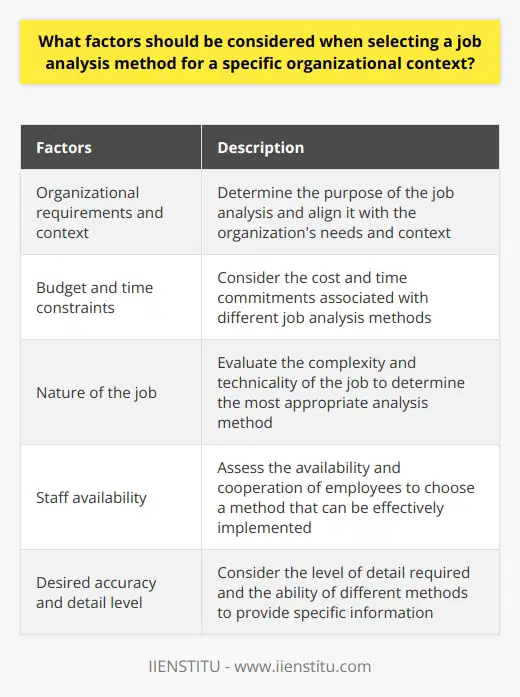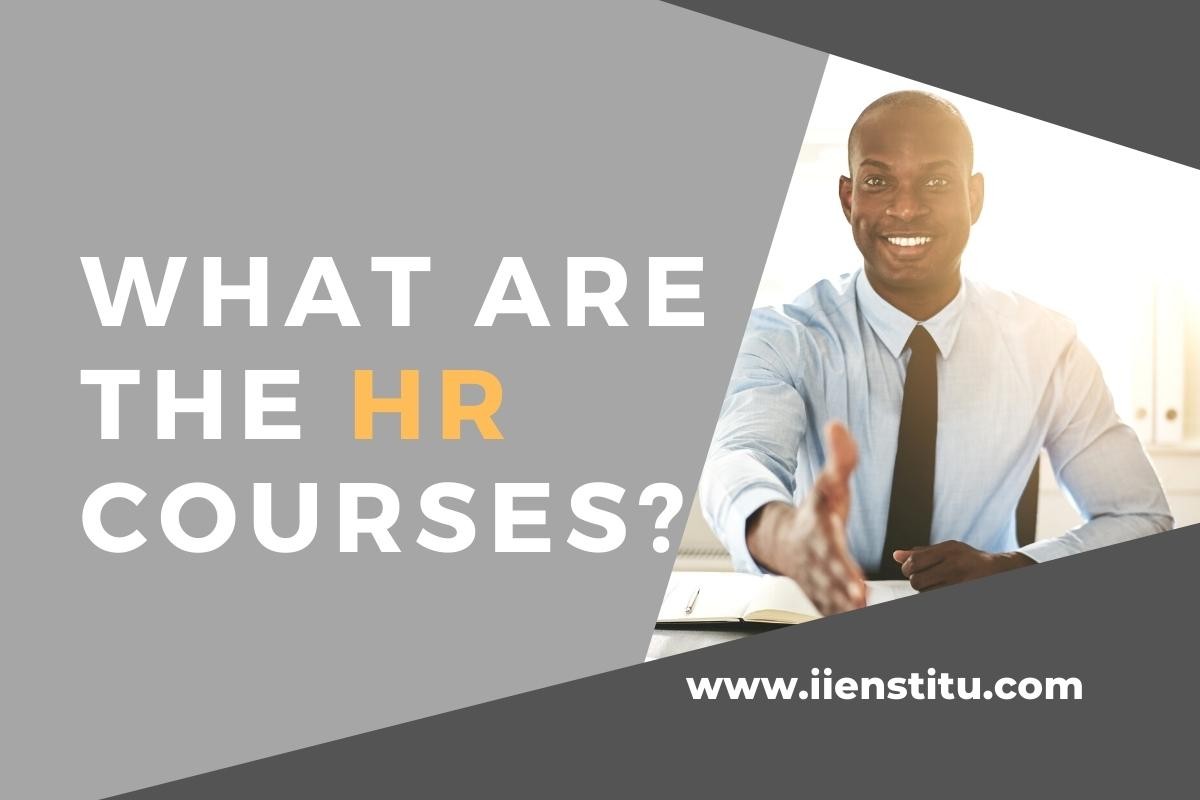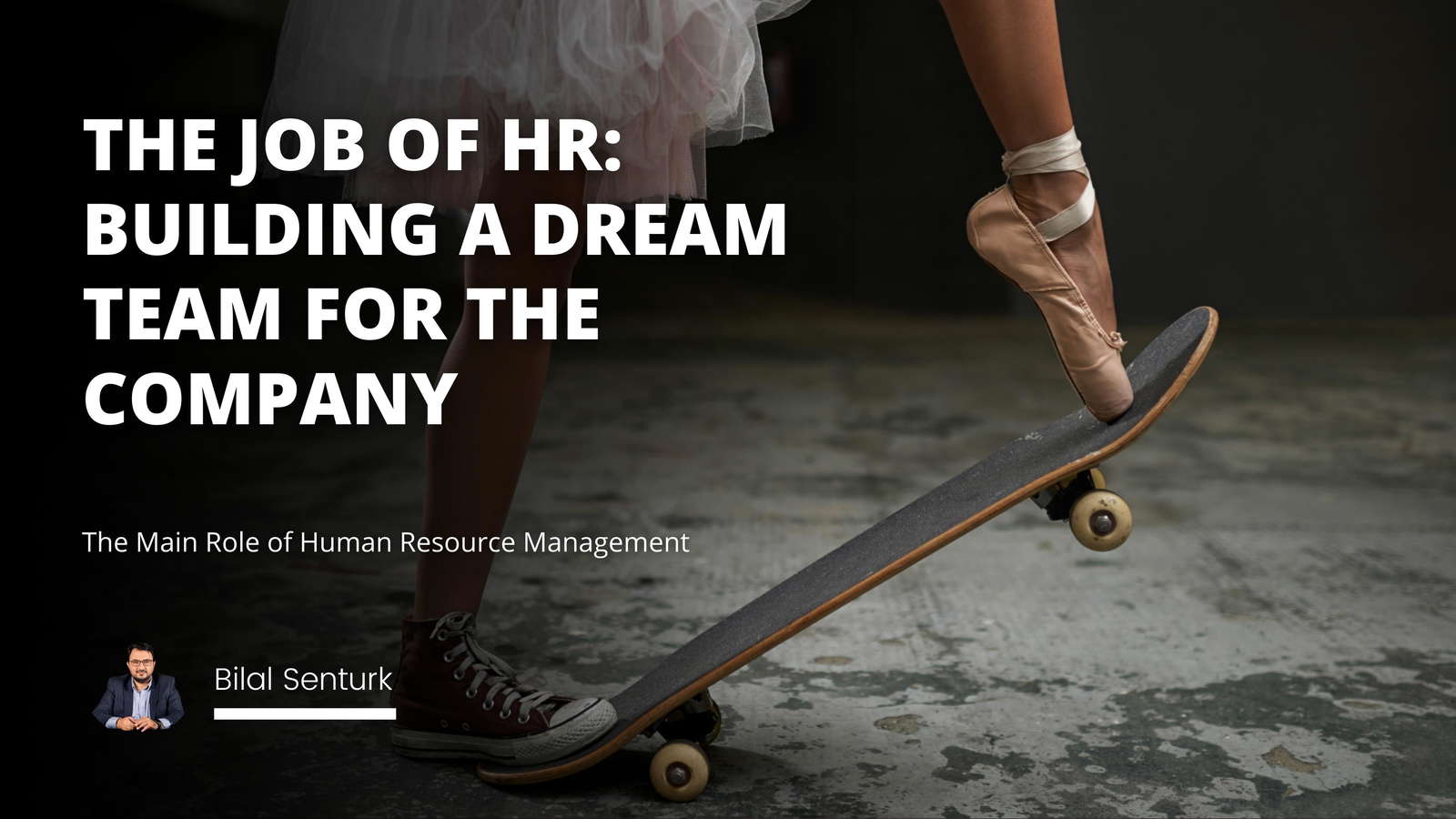
Overview of Job Analysis
Benefits of Job Analysis for Human Resources Development
Types of Job Analysis
Implementation Strategies for Job Analysis
Challenges and Limitations of Job Analysis
Job analysis is a foundational concept in human resources development. It is a process of systematically collecting and recording information about a particular job within an organization. It helps to identify the skills, knowledge, and abilities necessary for successful job performance. It is a critical part of the hiring and training process, as it accurately describes the job and its required qualifications.
By understanding the job and its components, HR professionals can develop effective recruitment, selection, and training strategies. This blog post will explore job analysis, its benefits, types, methods, and challenges.
Overview of Job Analysis
Job analysis is collecting and documenting the duties, tasks, and responsibilities associated with a job. It is used to understand what is required to perform the job and the skills and competencies needed to succeed. Additionally, job analysis helps identify the specific tasks, competencies, and training required for effective job performance. The information collected is also used to develop job descriptions and requirements for recruitment, selection, and training.
Benefits of Job Analysis for Human Resources Development
Job analysis is an essential tool for human resources development. It provides the foundation for various HR activities, from recruitment to training. It helps ensure that the right people are hired and trained. Additionally, job analysis provides insight into the skills and competencies required for each job. This information can be used to develop job descriptions and qualifications necessary for recruitment and selection. Additionally, job analysis helps identify areas where training and development are required, allowing HR professionals to develop effective training programs.
Types of Job Analysis
There are three main types of job analysis: functional, task-oriented, and competency-based. Available job analysis focuses on the overall job, identifying the duties, tasks, and responsibilities associated with the job. It also identifies the skills, knowledge, and abilities required for successful job performance. Task-oriented job analysis focuses on the tasks that make up the job and the skills and competencies necessary to complete each task. Finally, competency-based job analysis is focused on the competencies required for the job, such as problem-solving, communication, and leadership.
Related Course: Online Leadership Course
Implementation Strategies for Job Analysis
When implementing job analysis, it is essential to consider the organization's needs. Organizations should identify the information needed for the job analysis process and develop a plan for collecting and documenting the information. Additionally, organizations should develop a job description that accurately reflects the job and its requirements. This job description should be reviewed periodically to ensure it is current. Additionally, organizations should develop a training plan that includes the skills and competencies necessary for successful job performance.
Challenges and Limitations of Job Analysis
While job analysis is valuable for human resources development, it has challenges and limitations. The job analysis process's accuracy depends on the quality of the information collected. Additionally, job analysis can be time-consuming and costly, requiring significant time and resources. Additionally, job analysis can be subject to biases, as the analyst's personal views may influence the information. Finally, job analysis can be subjective, as it relies on the information and perceptions of the analyst.
Conclusion
Job analysis is an essential tool for human resources development. It provides the foundation for various HR activities, from recruitment to training. It is a process of collecting and documenting the duties, tasks, and responsibilities associated with a job. Additionally, job analysis helps identify the specific tasks, competencies, and training needed for effective job performance. While job analysis is a valuable tool, it has challenges and limitations. Therefore, organizations must consider these challenges and limitations when implementing job analysis.
Understanding job analysis is critical to unlocking the potential of any organization.
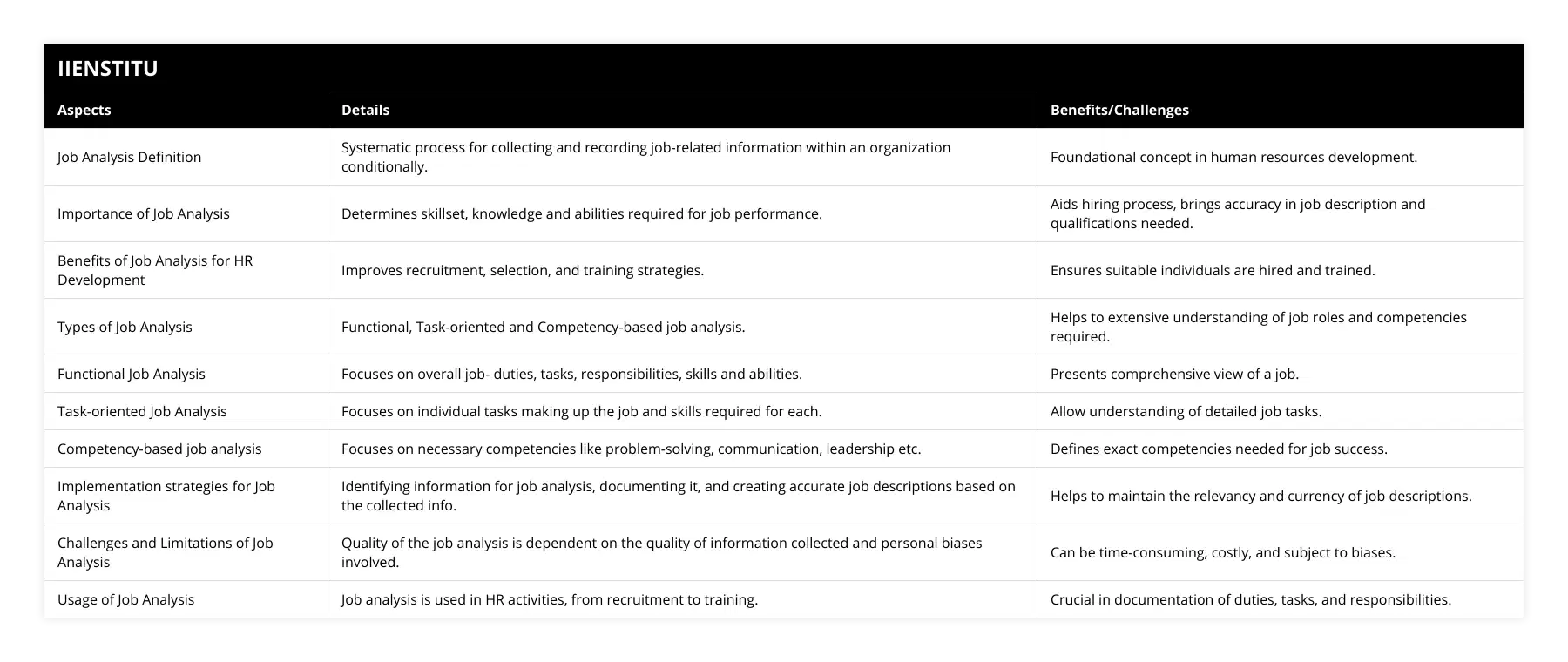
Frequently Asked Questions
What are the benefits of job analysis?
Job analysis is a systematic process of gathering, recording, and analyzing information about a particular position's job duties and requirements. It is typically used to identify and document the skills, abilities, knowledge, and other characteristics required to perform a job successfully. Job analysis also provides insight into how the job fits the organization's overall structure.
The benefits of job analysis are numerous. First, it helps ensure all employees are hired based on their qualifications for specific positions. By providing detailed information about what an employee must be able to do in order to be successful in a particular role, employers can make informed decisions when recruiting or promoting individuals. Secondly, job analysis helps organizations create meaningful job descriptions accurately describing each position's duties and responsibilities. This can help employers and employees better understand what is expected of them in their respective roles.
Furthermore, job analysis can help an organization identify training needs for its workforce. By understanding the skills needed for each position within the organization, managers can develop appropriate training programs to help employees become more effective. Additionally, managers can identify ways to improve efficiency or streamline processes by studying how jobs interact within an organization's structure.
Finally, it is essential to note that proper job analyses allow organizations to stay compliant with labor laws and regulations related to pay equity and discrimination avoidance. By understanding precisely what qualifies someone for specific positions or promotions within the company hierarchy, employers can avoid potential legal issues by ensuring that all hiring decisions are based on merit and not other factors such as race or gender.
In summary, numerous benefits are associated with performing accurate job analyses within organizations ranging from improved recruitment processes to greater compliance with labor laws and regulations related to pay equity and discrimination avoidance.

What are the different types of job analysis?
Job analysis is an essential part of the human resources process, as it helps identify the skills and abilities required for a given job and assess potential applicants' qualifications. Job analysis involves gathering and analyzing information about a particular job's duties, responsibilities, necessary skills, outcomes, and work environment. Several types of job analysis can be used to gain this information, including task analysis, personality analysis, and competency-based Analysis.
Task Analysis is the most common type of job analysis, and it involves breaking down a job into its component tasks and activities. Task analysis helps to identify what a job entails and what knowledge, skills, and abilities are needed to perform it. It also helps to define the expectations of the job and how to measure performance.
Personality Analysis involves the Analysis of the characteristics and traits necessary to perform a job successfully. This type of Analysis helps predict how an individual may perform in the job by looking at their personality traits, such as conscientiousness, agreeableness, and emotional stability.
Competency-Based Analysis is an approach to job analysis that focuses on the competencies required for successful job performance. This type of Analysis looks at the skills, abilities, and knowledge required for a job and the behaviors that indicate successful job performance.
Overall, job analysis is an integral part of the human resources process. It is used to identify the skills, abilities, and knowledge necessary for a job and the behaviors that indicate successful job performance. There are several types of job analysis, including task analysis, personality analysis, and competency-based Analysis. Each type of Analysis has its advantages and can help to provide valuable insight into a job and the qualifications of potential applicants.
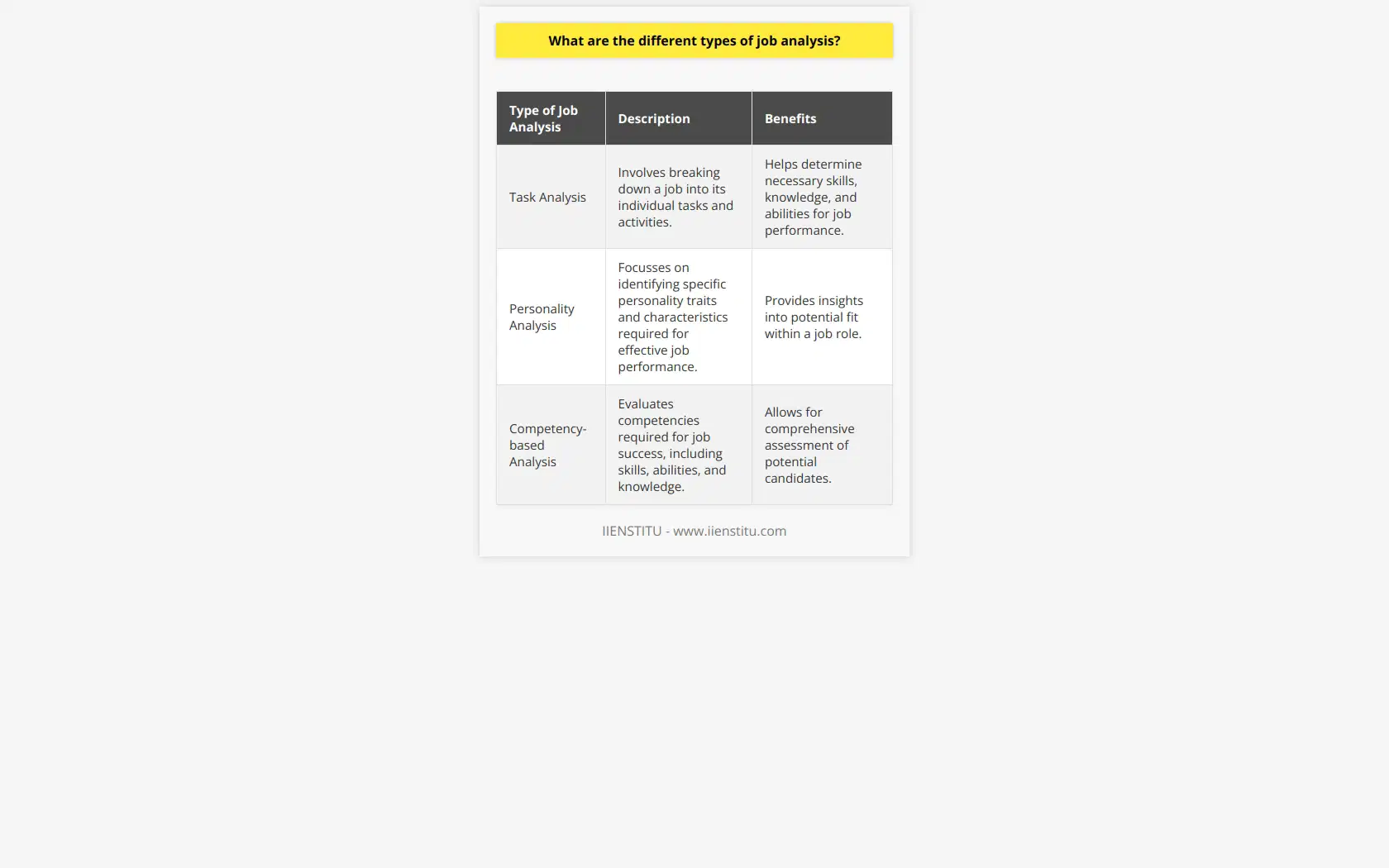
What strategies can be used to effectively conduct a job analysis?
Job analysis is an essential process in the human resources management of any organization. It involves collecting data about a job's tasks, duties, and responsibilities to determine the qualifications and skills necessary for successful performance. When properly conducted, job analysis can provide invaluable insights into the organizational structure and help employers create meaningful job descriptions that attract qualified candidates. This article will discuss some strategies that can be used to conduct a job analysis effectively.
The first step in conducting a job analysis is to define the project's scope. This includes determining which positions should be included and what information needs to be collected. It is essential to clearly define these parameters from the outset to ensure that all necessary information is collected and analyzed efficiently.
Once the scope has been established, selecting an appropriate method for collecting data about each position is essential. Standard methods include interviews with current employees or supervisors, surveys of employees or supervisors, observation of employees at work, and review of existing records such as job descriptions or performance evaluations. These methods should be carefully selected based on their ability to capture relevant information about each position accurately.
In addition, it is essential to develop a standardized set of questions or criteria for collecting data across all positions surveyed to ensure consistency and accuracy throughout the process. Questions should focus on topics such as required skills and qualifications; physical demands; mental requirements; working conditions; interpersonal relationships; decision-making processes; responsibility levels; reporting relationships; time commitments; training requirements; compensation structures; career progression opportunities; expected results or outcomes; safety concerns; ethical issues related to particular positions or tasks associated with them etc., depending on how comprehensive employers desire an understanding of each position.
Finally, employers need to systematically analyze all collected data using appropriate techniques such as statistical or qualitative analyses to draw meaningful conclusions regarding each position's requirements and qualifications needed for success within that role. Once this process has been completed successfully, employers can use these insights when making decisions regarding recruitment strategies, training programs, compensation packages, etc., thus ensuring their organization's long-term success through effective human resource management practices.
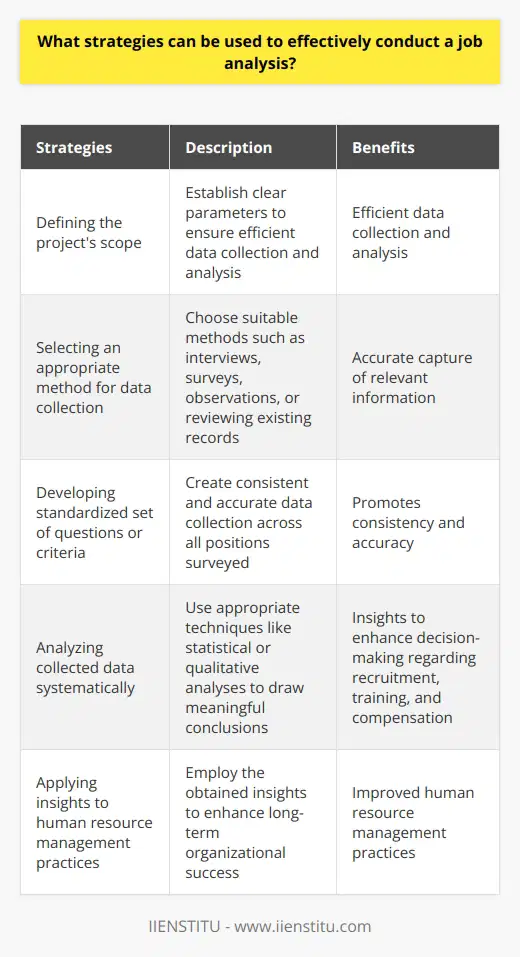
What are the key components of a comprehensive job analysis?
Job analysis Key Components
All job analyses must entail specific core components to ensure comprehensiveness. First and foremost, critical job tasks represent the foundation of any job analysis. Isolating the essential duties of a job role is crucial.
Importance of Skill Identification
A subsequent component is the identification of critical skills. These represent the specific aptitudes, knowledge, abilities and technical competencies indispensable to perform tasks effectively.
Role of worker characteristics
Furthermore, worker characteristics or attributes also form an integral part of a comprehensive job analysis. These cover the personal traits or dispositions, such as physical attributes and attitudes, necessary for job performance.
Job Contexts Importance
Another element of a comprehensive analysis is understanding the job context. This includes the work environment, job conditions, or physical and social aspects of the job, which may impact performance.
Performance Standards
Lastly, comprehensive job analyses necessitate clearly defined performance standards. These standards facilitate performance measurement, objective setting, and offer critical reference points during appraisals.
Overall, a comprehensive job analysis encompasses the tasks, skills, worker attributes, job context, and performance standards. Therefore, researchers and HR professionals must consider these five components to ensure a thorough, valid, and reliable job analysis. They aid in clearly defining roles, responsibilities, and expectations, thereby promoting improved job design, recruitment, and appraisals.
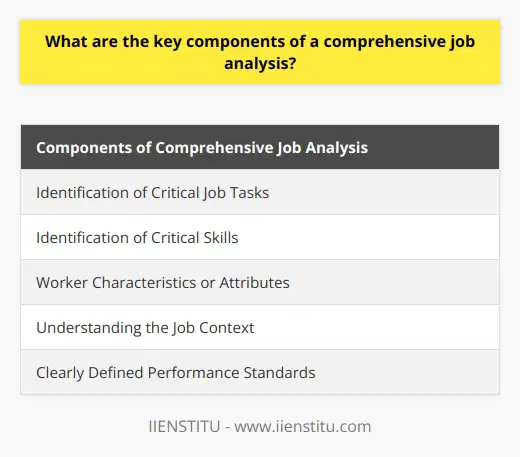
How do various job analysis methods align with different organizational goals and objectives?
Job Analysis Methods and Organizational Goals
Job analysis plays a significant role in aligning workplace processes with organizational goals. Several methods exist, each supporting different objectives.
Criticial Incident Technique and Job Performance
The Critical Incident Technique (CIT) involves identifying key behaviors that result in job success or failure. This method helps in designing performance management tools, aligning them with the company's productivity goals.
Functional Job Analysis and Staffing Goals
Functional Job Analysis (FJA) categorizes jobs according to areas of responsibility and required knowledge and skills. When an organization seeks to enhance staffing efficiency, this method is preferred.
Job Element Method and Training Objectives
The Job Element Method (JEM) identifies the attributes necessary for job performance. Organizations use this strategy to design effective training and development programs.
Position Analysis Questionnaire and Compensation Plans
The Position Analysis Questionnaire (PAQ) helps to quantify job tasks and determine their difficulty levels. It aligns with salary and compensation planning.
Work Sampling Method and Process Improvement
The Work Sampling Method involves monitoring employees as they perform routine tasks. Insights gained help managers improve workflow efficiency and set realistic timelines, aligning with organizational objectives of process optimization.
In conclusion, job analysis methods provide structure and goal alignment for organizational units. They facilitate successful implementation of performance management, staffing, training, compensation, and process improvement systems.
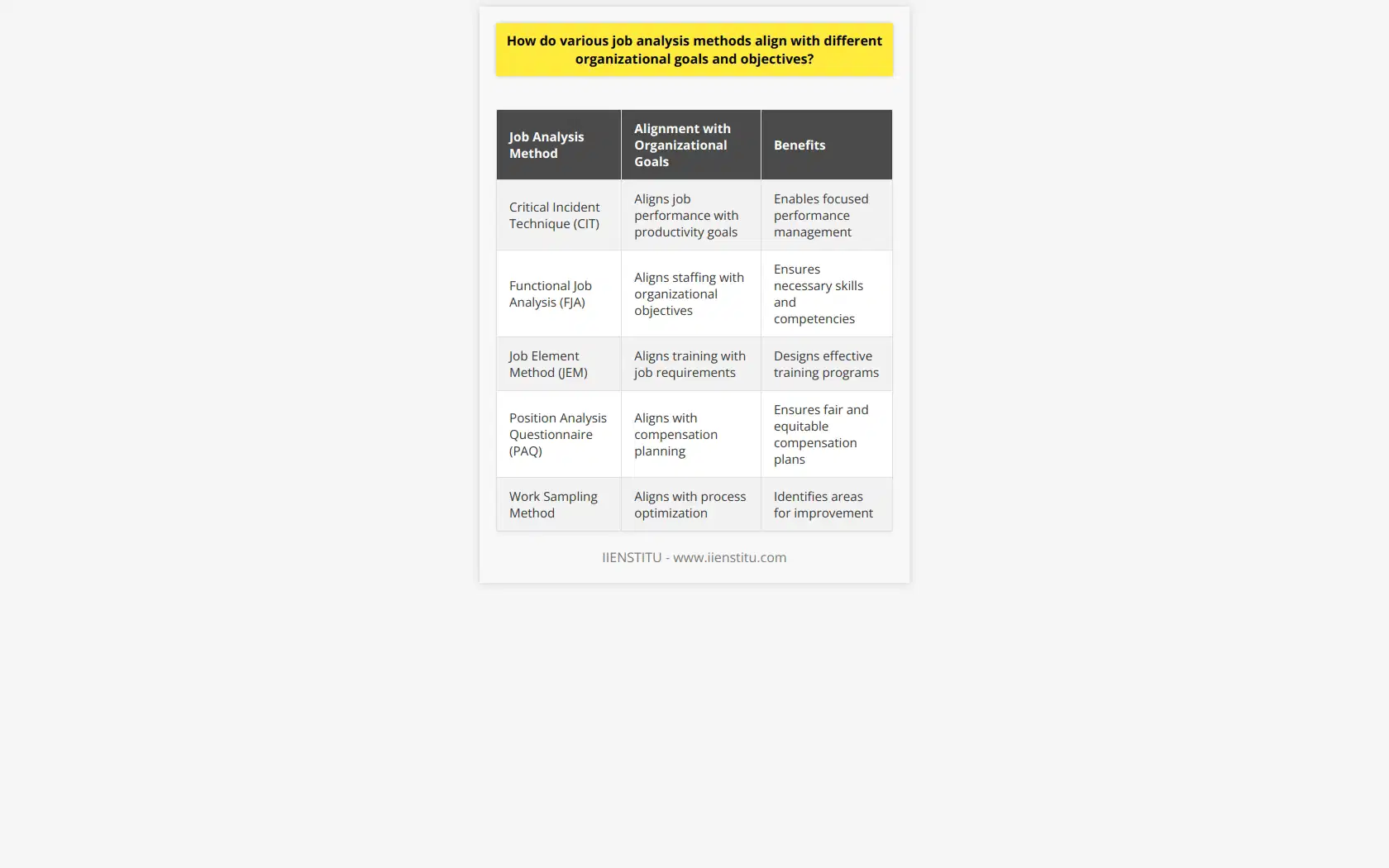
In what ways can the results of a job analysis be applied to improve organizational performance and employee satisfaction?
Job Analysis and Organizational Performance
One key application of job analysis results lies in improving organizational performance. A detailed job analysis can identify inefficiencies within different roles, stations, departments, or the entire organization itself. It also pinpoints remote skills required for optimal performance. Organizations can use these findings to mitigate job redundancies, redistribute workload, or retrain employees, which all lead to improved operational efficiency.
Staffing and Training
In staffing, job analysis results point to the specific skills, aptitudes, and experiences required of future employees. This leads to better recruitment decisions because organizations have a clear standard for comparison. The same results can also guide employee training and development. Training programs that align with job analysis results stand a higher chance of success as they address the right knowledge and skill gaps.
Job Satisfaction and Employee Morale
Job satisfaction is another area that can significantly benefit from job analysis. Accurate job descriptions can create appropriate candidate expectations and thus, reduce turnover. If employees understand what the organization expects of them, they are less likely to experience job dissatisfaction and leave prematurely. In addition to clarifying roles, job analysis also aids in setting competitive compensations. Fair remuneration based on clear-cut job evaluation boosts employee morale and satisfaction.
Performance Management and Organizational Strategy
Lastly, job analysis plays a critical role in performance management. The insights derived from this process provide a objective basis for appraisals, promotions, and transfers. Equally, it becomes easier to identify problematic areas or employees, and seek timely interventions. Over time, continual assessments and adjustments align individual roles with the overall organizational strategy – a surefire strategy for optimal performance.
In conclusion, the systematic job analysis has broad implications for both organizational performance and employee satisfaction. Its successful application demands both careful planning and rigorous follow-through.
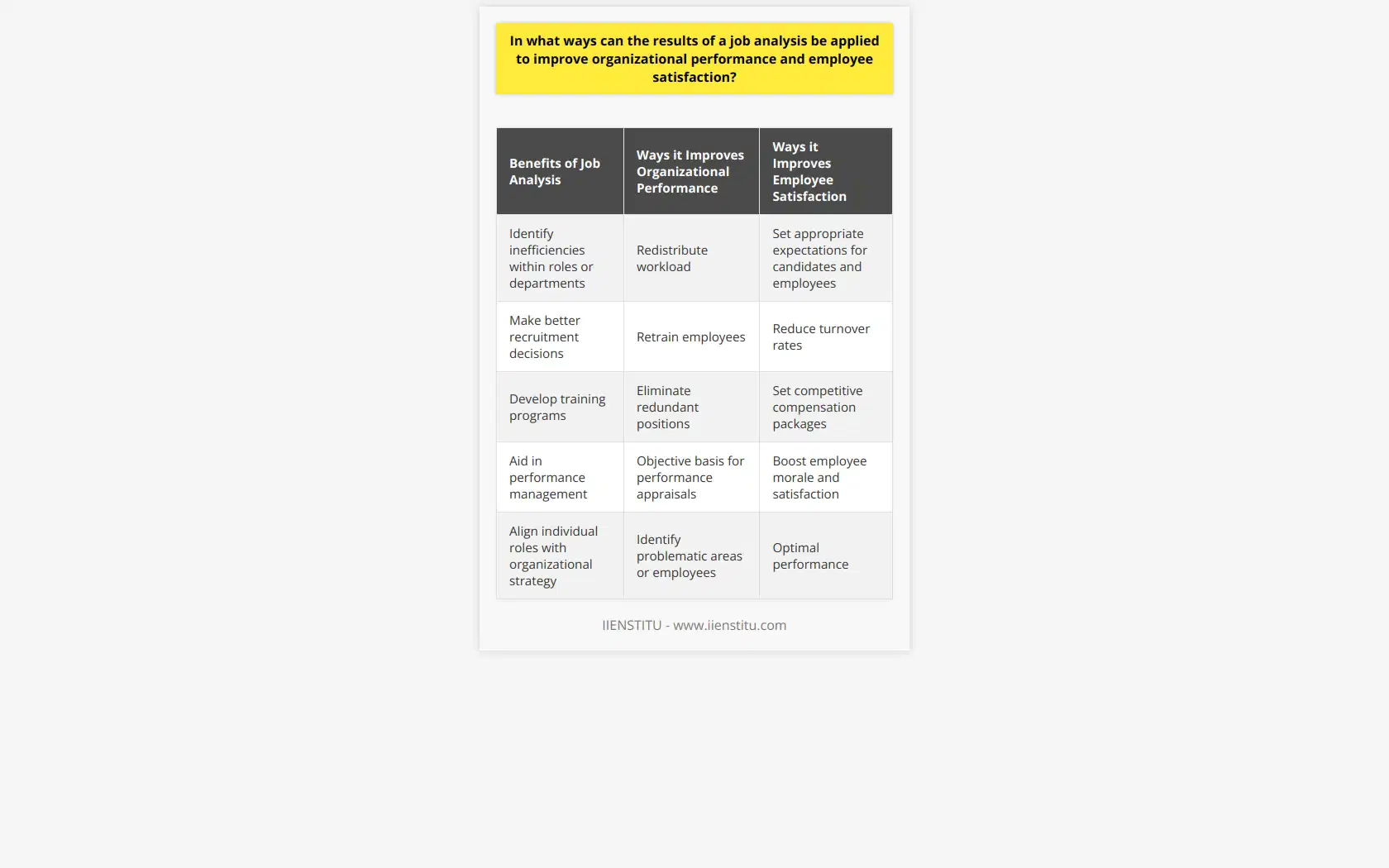
What are the 7 methods of job analysis?
Job Analysis Methods Overview:
The first method of job analysis is the observational method. Here, job analysts observe workers perform their tasks and note down their duties. The second is the interview method, in which analysts converse directly with employees, asking for detailed information about their responsibilities.
Work Diary Method:
The work diary method involves employees keeping a record of their daily activities. This provides a broad and comprehensive view of their role. This contrasts with the fourth method, the critical incident technique. Here, they record only unusual events that occurred in the job and their reactions to them, thereby enhancing the understanding of unpredictable elements in a job.
Questionnaires and Surveys:
The fifth method is the administration of questionnaires or surveys. Structured or open-ended, these tools solicit workers' insights into their tasks, the complexity of their jobs, and the skills necessary for their roles.
Task Inventory Analysis and Job Element Method:
Task inventory analysis, the sixth method, involves identifying the various tasks performed in a job and categorizing them based on their frequency and importance. Lastly, the job element method goes into specifics, focusing on the human attributes necessary to perform the job, such as physical abilities, mental capabilities, and interpersonal skills.
In summary, the seven methods of job analysis include the observational method, interview method, diary method, critical incident technique, questionnaire and surveys, task inventory analysis, and job element method. These methods facilitate understanding job specifics, employee duties, and the skills required for a job to develop an accurate job description.
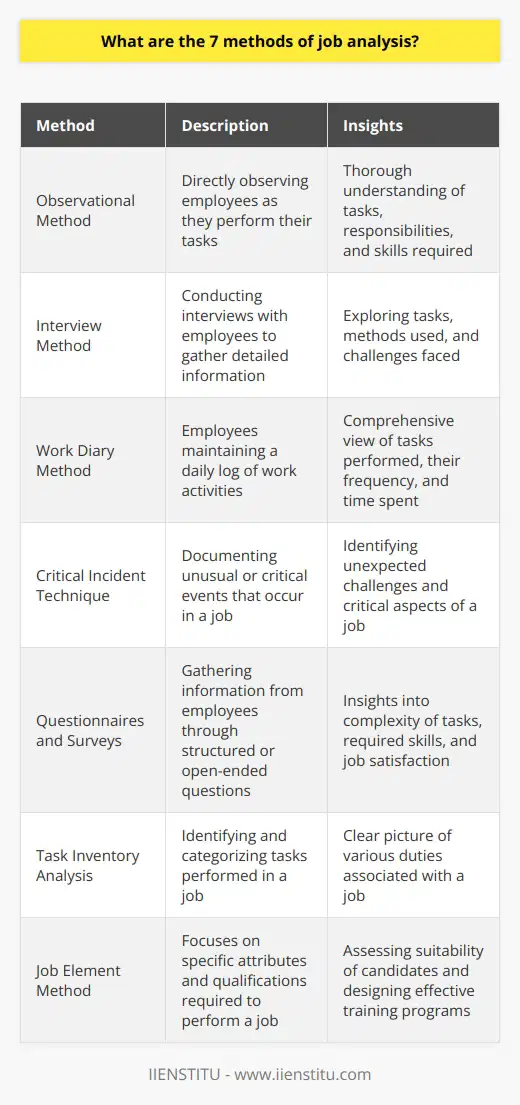
How can job analysis contribute to the development of effective human resource management strategies?
Job Analysis and HRM Strategies
Job analysis plays a crucial role in creating effective human resources management (HRM) strategies. It aids in addressing workforce needs, functional dynamics, and organizational structures.
Understanding Workforce Requirements
Initially, job analysis helps define the specific tasks, skills, knowledge, and abilities necessary for a position. This understanding allows HR professionals to choose appropriate recruitment and selection methods.
Enhancing Employee Performance
Secondly, a comprehensive job analysis informs performance management systems. It offers insight into the essential job functions, forming a basis for evaluation standards and performance appraisals.
Supporting Compensation and Benefits
Thirdly, job analysis contributes to designing fair compensation and benefits strategies. By comparing required job competencies and market salaries, businesses can offer competitive pay rates to attract and retain talent.
Nurturing Professional Development
Additionally, it facilitates professional development schemes. By identifying the skill gaps, HR can design tailored training and development plans for employees.
Promoting Compliance and Diversity
Lastly, job analysis helps ensure legal compliance and diversity in the hiring process. It provides a clear picture of the job requirements, promoting unbiased decision-making in recruitment processes.
In summary, job analysis is a necessary tool for developing effective HRM strategies. It aids in decision-making across key HRM processes such as recruitment, performance management, compensation, professional development, and legal compliance.
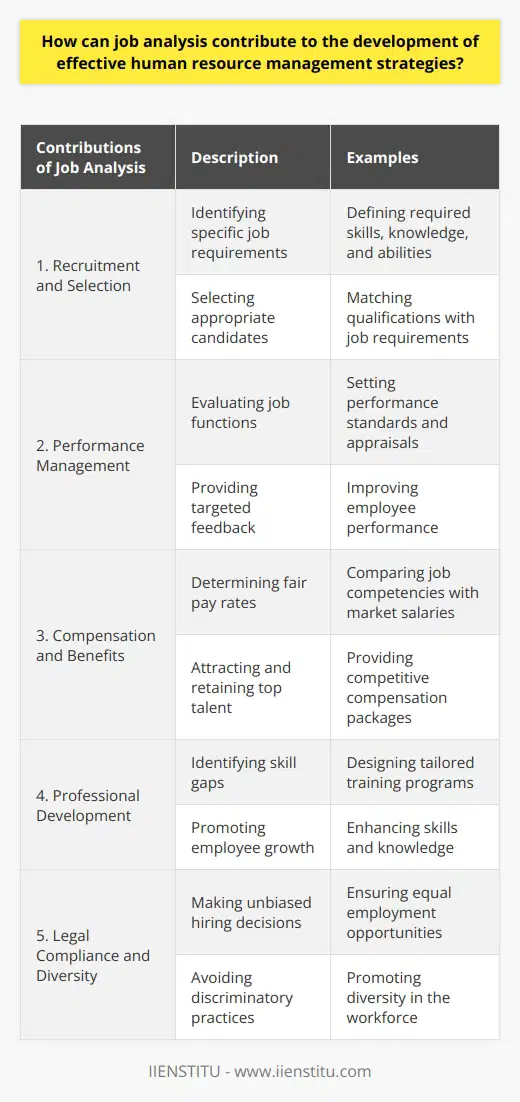
What factors should be considered when selecting a job analysis method for a specific organizational context?
Organizational Requirements and Context
Choosing the relevant job analysis method primarily relies on understanding an organization's needs and context. Firstly, we must consider the reason for the job analysis –whether its purpose is staff hiring, job progression, or performance appraisal. The intended use should guide the selection of the right tool.
Budget and Time Constraints
Another vital consideration involves the budgetary and time constraints. Different analysis methods incur varying costs and require diverse time commitments. For instance, the interview method could be more time-consuming and expensive compared to a questionnaire approach.
Nature of the Job
The job's nature and complexity also play a significant role in job analysis method selection. For technical or complex job roles, methods such as observation or work sampling might be more appropriate to capture the job's nuances. On the other hand, for generic or simple jobs, a questionnaire could suffice.
Staff Availability
Additionally, the availability and cooperation of the employees affect the chosen method. In situations where employees are dispersed or where union rules may limit direct observation, self-reporting methods like questionnaires might be more appropriate.
Accuracy and Detail Level
Lastly, the level of accuracy and detail required reflects on the chosen method. While critical incident method may provide detailed and specific information, questionnaires might offer more generalized data. Choice between these methods relies on the depth of information needed.
In conclusion, the selection of any job analysis method should be a strategic decision influenced by multiple factors such as organizational requirements, budget, time, nature of job, staff availability, and desired accuracy. Therefore, there is no one-size-fits-all method, rather it requires careful evaluation and consideration of these factors.
